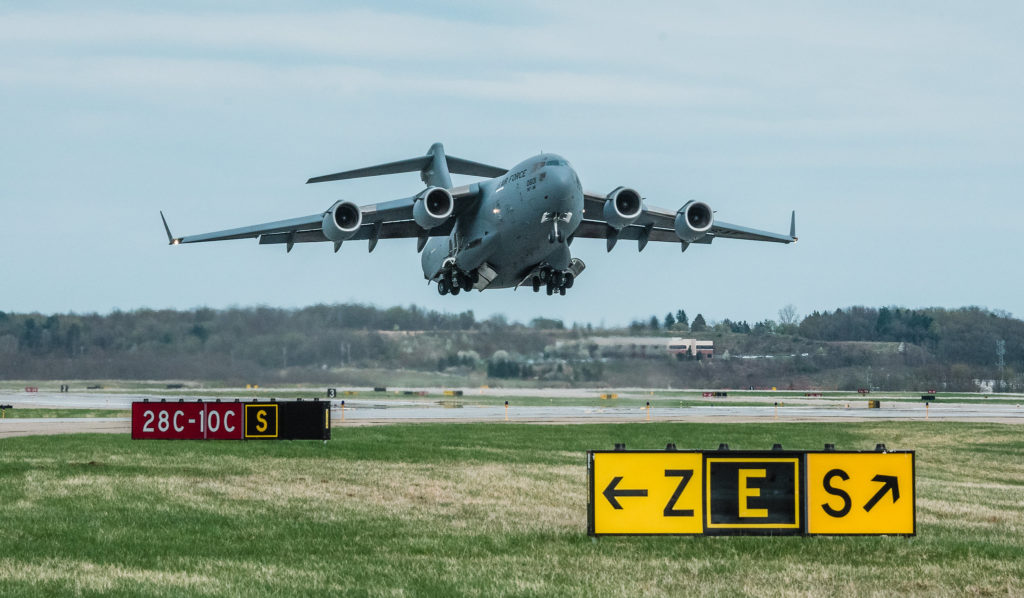911th Airlift Wing Assisting With COVID-19 Relief Efforts
Pittsburgh’s Air Force Reserve station continues global mission, including pandemic response
By Natalie Fiorilli
Published April 6, 2020
Read Time: 3 mins
During times of national crisis, U.S. military service members can be asked to assist in a moment’s notice.
Over the weekend, that request was made of Pittsburgh International Airport’s military neighbor, the 911th Airlift Wing, which shares the airfield. On Sunday, 10 members of the 911th were mobilized to assist with COVID-19 relief efforts in New York City.
“We’re always prepared to answer the call when the call comes,” said Marjorie Schurr, the 911th’s chief of public affairs. “[This weekend], we probably had between 24 to 48 hours’ notice. So once things started moving, they were moving very quickly.”
Schurr said the deployment is part of a larger mobilization taking place throughout the Air Force Reserve Command nationwide. The group of airmen selected from the 911th have medical experience and will work to support doctors, nurses and other healthcare professionals in New York.
In March, President Trump authorized a potential mobilization of select National Guard and Reserve members, as well as former service members in the Individual Ready Reserve, to assist with national COVID-19 response efforts.
Amid the national pandemic, the Pittsburgh station stands ready to respond to additional requests while maintaining its normal operations, which includes flying the C-17 Globemaster III aircraft.

The C-17 can fly greater distances compared to the C-130 and handle payloads as large as 85 tons. (Photo by Beth Hollerich)
“We are taking all of the prudent measures that we possibly can to protect our airmen, while still responding to the call to defend our nation,” Schurr said. “Our planes are still flying to different locations all over the world to respond to that need.”
The unit is practicing social distancing and other healthy guidelines outlined by the CDC and World Health Organization. Some service members are also working remotely.
“We still have a military mission to take care of,” said Maj. Wesley E. Cranmer Jr., a pilot for the 911th. “We’ve been talking about that all weekend. We still have air crews that have to be postured to support our military operation, because there’s really no one else in the world that can do what the Air Force can do. We have the ability to reach out internationally, all around the world, in such a short period of time.”
Over the past few years, the base has changed its entire mission. The 911th relocated its fleet of C-130 aircraft and began flying the newer and larger C-17 in 2019.
Crews are now flying on long-haul missions and can be deployed more frequently. With the ability to land on short and narrow runways, C-17 aircraft are used for missions ranging from airlifts to hauling large equipment and supplies, including transporting ambulatory patients.
Because of this, members of the 911th must always be prepared to mobilize for a variety of missions, which can include humanitarian operations such as COVID-19 relief efforts.
“We could go anywhere we are tasked to within a very short time frame,” said Maj. Cranmer. “It’s why I signed up—to help in all different regards.”
As the 911th maintains its normal operations, the reserve unit remains prepared to assist in additional efforts in response to the national health crisis.
“Wherever our people are needed, we have to be ready to go at all times, which means we have to work diligently, no matter what, to ensure that we are prepared to respond to that need,” Schurr said.
“We stand ready to respond to our nation’s call, whenever it may come, in whatever form and wherever we’re required to go.”
Similarly, PIT remains open and fully operational to support its military neighbors of the 911th and 171st Air Refueling Wing, among other critical operations including cargo and essential travel.
Watch
This Next
Read
This Next





